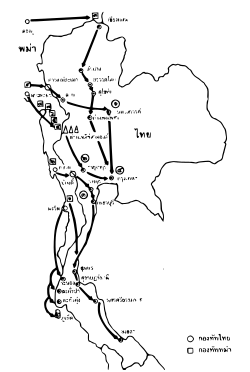Burmese–Siamese War (1785–1786)
The Burmese–Siamese War (1785–1786), known as the Nine Armies' Wars in Siamese history because the Burmese came in nine armies, was fought between the Konbaung dynasty of Burma and the Chakri dynasty of resurgent Siam (Thailand).
| Burmese–Siamese War (1785–1786) | |||||||||
|---|---|---|---|---|---|---|---|---|---|
| Part of the Burmese–Siamese wars | |||||||||
 Map showing Burmese invasion routes and defensive points of Siamese side in Thai language | |||||||||
| |||||||||
| Belligerents | |||||||||
|
|
| ||||||||
| Commanders and leaders | |||||||||
|
|
| ||||||||
| Units involved | |||||||||
|
|
| ||||||||
| Strength | |||||||||
| 144,000[1][2] | 70,000 | ||||||||
| Casualties and losses | |||||||||
| ~70,000 | ~15,000 | ||||||||
In early 1785, King Bodawpaya of Konbaung dynasty sent an expedition force to take Jung Ceylon (Phuket) to prevent foreign arms shipments to Siam but the invasion force was driven back. In October 1785, Bodawpaya pursued an ambitious campaign to expand his dominions into the lands of the former Ayutthaya Kingdom. He launched a four-pronged invasion towards Chiang Mai, Tak, Kanchanaburi, and Jung Ceylon. The combined strength was about 50,000 men. The invasion forces faced heavy resistance from the Siamese forces and finally the war became a total disaster for Burma. The failed invasion ultimately turned out to be the last full-scale invasion of Siam by Burma.
Invasion (1785)
Northern theatre
In mid-October 1785, King Bodawpaya armies attacked Lanna in northern Siam, where Kawila, Prince of Lampang, put up a brave fight and delayed the Burmese advance, all the while waiting for reinforcements from Bangkok. When Phitsanulok was captured, Anurak Devesh of the Rear Palace, and Rama I himself led Siamese forces to the north. The Siamese relieved Lampang from the Burmese siege.
Southern theatre
In the south, Bodawpaya lay waiting at Chedi Sam Ong. The Front Palace (Maha Sura Singhanat) led his troops to the south the counter-attack the Burmese that came from Ranong through Nakhon Si Thammarat. The engagements occurred at Kanchanaburi. The Burmese also attacked Jung Ceylon (Phuket), where the governor had just died. Chan, wife of the governor, and her sister Mook gathered people to defend Mueang Thalang against the Burmese, after Francis Light, a British East India Company captain passing by the island. Light went ashore to warn of an impending invasion. After a month-long siege of the capital city, the Burmese were forced to retreat on 13 March 1785. Today, Chan and Mook are revered as the two heroines, Thao Thep Kasattri and Thao Sri Sunthon.
The Burmese captured Songkhla. Upon hearing the news, the governors of Phatthalung Province fled. However, a monk named Phra Maha headed a force of villagers against the Burmese. His campaign was also successful. Phra Maha was later raised to Phraya Thukkharat by Rama I.[3]
Retreat
Aside from the Burmese northern army which took Chiang Mai and swept down to Lampang, the Burmese southern armies were driven back, and in one case, nearly annihilated. All of the Burmese invasion armies withdrew in disarray in late-January 1786.
Tha Din Daeng campaign (1786)
King Bodawpaya renewed attacks in early 1786. This time, he didn’t divide his troops but instead formed into single army. Bodawpaya passed through the Chedi Sam Ong and settled in Tha Din Daeng. Maha Sura Singhanat marched the Siamese forces to face Bodawpaya. The fighting was very short and Bodawpaya was quickly defeated. This short war was called “Tha Din Daeng campaign”.
The campaign is commemorated by a park established by the Royal Thai Army 40 kilometres (25 mi) from the town of Kanchanaburi.[4]
See also
- Burmese–Siamese wars
- Burma–Thailand relations
References
- "Archived copy". Archived from the original on 2012-05-14. Retrieved 2012-04-02.CS1 maint: archived copy as title (link)
- "Archived copy". Archived from the original on 2015-12-25. Retrieved 2012-04-02.CS1 maint: archived copy as title (link)
- "Phraya Thukkharat (Chuai) Monument". Thailand Travel Information. 2TourThailand.com. August 15, 2011. Retrieved August 15, 2011.
Later, he left the monkhood and was royally appointed as Phraya Thukkharat in charge of official duties as an assistant to the city ruler.
- "The Nine-Army Battle Historical Park". Tourism Authority of Thailand (TAT). Retrieved 11 September 2016.